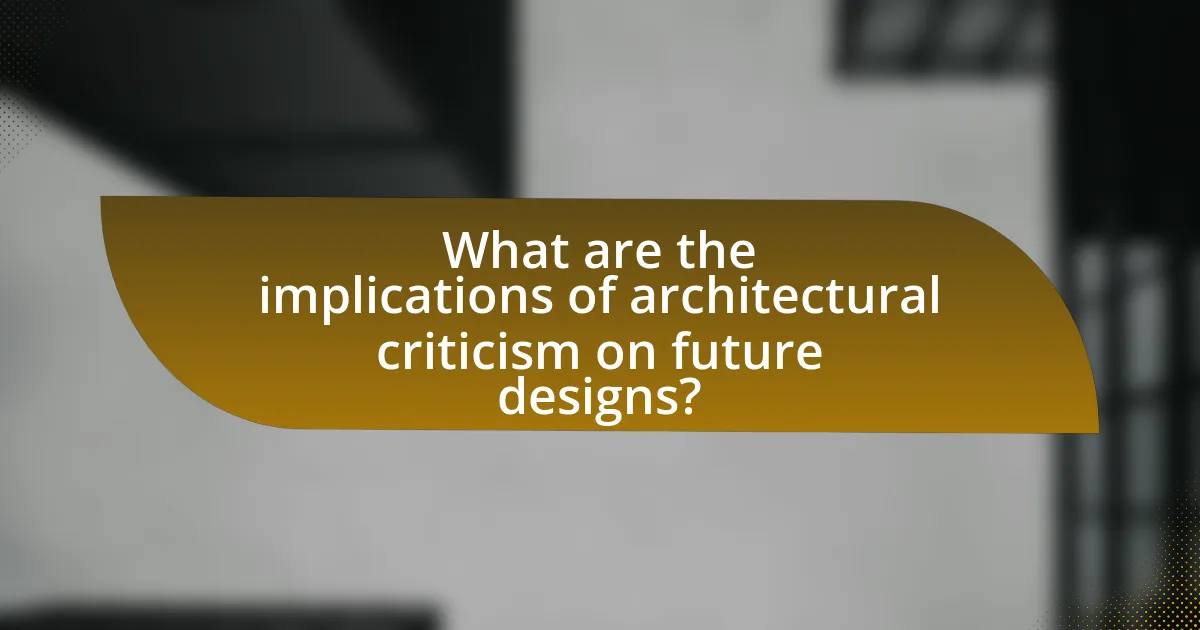Case studies in architectural criticism provide in-depth analyses of specific buildings, evaluating their design, context, and societal impact. This article explores the significance of iconic structures, such as the Guggenheim Museum in Bilbao and the Sydney Opera House, highlighting how they reflect cultural narratives and influence architectural practices. It discusses various methodologies used in case studies, the role of public perception, and the implications of architectural criticism on future designs. Additionally, it examines how lessons from these case studies can inform contemporary architecture, emphasizing sustainability, user-centered design, and community engagement.

What are Case Studies in Architectural Criticism?
Case studies in architectural criticism are in-depth analyses of specific buildings or architectural projects that evaluate their design, context, and impact. These studies often focus on iconic structures, examining how they reflect cultural, social, and historical narratives. For instance, the case study of the Guggenheim Museum in Bilbao highlights how its innovative design by Frank Gehry transformed the urban landscape and boosted local tourism. Such analyses provide critical insights into architectural practices and contribute to the broader discourse on the role of architecture in society.
How do case studies contribute to architectural criticism?
Case studies contribute to architectural criticism by providing detailed analyses of specific buildings, which reveal insights into design principles, cultural context, and user experience. These in-depth examinations allow critics to assess the effectiveness of architectural choices and their impact on society. For instance, the case study of the Sydney Opera House illustrates how innovative design can challenge traditional architectural norms and enhance public engagement, demonstrating the importance of context in architectural evaluation. Such examples validate the role of case studies in fostering a deeper understanding of architecture’s multifaceted nature.
What methodologies are used in architectural case studies?
Architectural case studies utilize various methodologies, including qualitative analysis, comparative analysis, and historical analysis. Qualitative analysis focuses on gathering in-depth insights through interviews, observations, and document reviews, allowing researchers to understand the context and impact of architectural designs. Comparative analysis involves examining multiple case studies to identify patterns and differences, which can reveal broader architectural trends and principles. Historical analysis places architectural works within their historical context, assessing how cultural, social, and technological factors influenced design decisions. These methodologies are validated by their widespread application in academic research and professional practice, demonstrating their effectiveness in deriving meaningful conclusions about architectural significance and innovation.
How do case studies enhance our understanding of iconic buildings?
Case studies enhance our understanding of iconic buildings by providing detailed analyses of their design, context, and impact. These studies allow researchers and architects to explore the architectural choices made, the cultural significance of the buildings, and the historical context in which they were created. For instance, the case study of the Guggenheim Museum in Bilbao illustrates how Frank Gehry’s innovative design transformed the city’s identity and boosted its economy through cultural tourism. Such concrete examples demonstrate how case studies serve as valuable tools for learning about architectural principles, societal influences, and the evolution of design practices.
Why are iconic buildings significant in architectural criticism?
Iconic buildings are significant in architectural criticism because they serve as benchmarks for evaluating design, cultural impact, and innovation within the field. These structures often embody unique architectural styles and philosophies, influencing both contemporary and future designs. For example, the Guggenheim Museum in Bilbao, designed by Frank Gehry, is frequently cited for its groundbreaking use of form and material, which sparked discussions on deconstructivism and urban revitalization. Such buildings not only reflect the technological advancements of their time but also provoke critical discourse on aesthetics, functionality, and social context, making them essential subjects in architectural criticism.
What characteristics define an iconic building?
Iconic buildings are defined by their distinctive architectural style, cultural significance, and ability to evoke strong emotional responses. These structures often feature innovative design elements that set them apart from conventional architecture, such as unique shapes, materials, or construction techniques. For example, the Sydney Opera House is renowned for its sail-like roof design, which has become a symbol of Australia. Additionally, iconic buildings frequently represent historical or cultural milestones, serving as landmarks that embody the identity of a city or region, such as the Eiffel Tower in Paris. Their recognition and memorability contribute to their status as iconic, making them subjects of admiration and study in architectural criticism.
How do cultural and historical contexts influence iconic status?
Cultural and historical contexts significantly influence iconic status by shaping public perception and meaning associated with a structure. For instance, the Eiffel Tower, built in 1889, became a symbol of French innovation and cultural pride during the Industrial Revolution, reflecting the era’s technological advancements and national identity. Similarly, the Sydney Opera House, completed in 1973, embodies Australia’s cultural aspirations and identity, influenced by its unique geographical and historical context. These examples demonstrate that the significance and recognition of iconic buildings are deeply rooted in the cultural narratives and historical events surrounding them, which contribute to their lasting impact and status in society.

What lessons can be learned from specific case studies?
Specific case studies in architectural criticism reveal that design decisions significantly impact functionality, aesthetics, and sustainability. For instance, the case study of the Sydney Opera House illustrates the importance of integrating innovative design with environmental considerations, as its unique shell structure not only serves an artistic purpose but also enhances acoustics and energy efficiency. Similarly, the Guggenheim Museum in Bilbao demonstrates how architecture can revitalize urban spaces and stimulate local economies, as evidenced by a reported increase in tourism and business activity following its completion. These examples underscore the necessity of considering context, user experience, and environmental impact in architectural design.
How do different case studies illustrate architectural principles?
Different case studies illustrate architectural principles by providing concrete examples of design concepts, materials, and spatial organization in real-world applications. For instance, the Guggenheim Museum in Bilbao, designed by Frank Gehry, exemplifies the principle of form following function, as its organic shapes enhance the visitor experience while accommodating art display needs. Similarly, the Villa Savoye by Le Corbusier showcases the principles of modernism, emphasizing functionality and the use of pilotis, open floor plans, and horizontal windows to create a harmonious relationship between the interior and exterior spaces. These case studies serve as tangible evidence of how theoretical architectural principles manifest in practice, allowing for analysis and learning from their successes and challenges.
What are key examples of successful architectural designs?
Key examples of successful architectural designs include the Sydney Opera House, the Guggenheim Museum in Bilbao, and the Burj Khalifa. The Sydney Opera House, designed by Jørn Utzon, is renowned for its unique shell-like structure and has become an iconic symbol of Australia since its completion in 1973. The Guggenheim Museum, designed by Frank Gehry and opened in 1997, is celebrated for its innovative form and has significantly boosted Bilbao’s economy and cultural status. The Burj Khalifa, completed in 2010 and designed by Adrian Smith, stands as the tallest building in the world, showcasing advanced engineering and design techniques. Each of these structures exemplifies how architectural innovation can enhance cultural identity and urban development.
How do failures in architecture inform future designs?
Failures in architecture inform future designs by highlighting critical lessons that lead to improved safety, functionality, and aesthetics. For instance, the collapse of the Tacoma Narrows Bridge in 1940 revealed the importance of aerodynamics in structural design, prompting engineers to incorporate wind tunnel testing in future projects. Similarly, the issues faced by the Pruitt-Igoe housing complex in the 1950s underscored the need for community-oriented design and maintenance considerations, influencing urban planning practices thereafter. These historical failures serve as case studies that architects and engineers analyze to avoid repeating mistakes, thereby enhancing the overall quality and resilience of future architectural endeavors.
What role does public perception play in architectural criticism?
Public perception significantly influences architectural criticism by shaping the evaluation and acceptance of buildings within society. Critics often consider how the public reacts to a structure, as this response can reflect broader cultural values and priorities. For instance, the reception of the Sydney Opera House demonstrates that public admiration can elevate a building’s status, while negative perceptions can lead to criticism and calls for redesign, as seen with the Pruitt-Igoe housing complex, which was ultimately demolished due to public discontent. Thus, public perception serves as a critical lens through which architectural merit is assessed, impacting both the reputation of architects and the future of architectural practices.
How do community responses shape the evaluation of iconic buildings?
Community responses significantly shape the evaluation of iconic buildings by influencing public perception and acceptance. When communities engage with architectural projects, their feedback can lead to alterations in design, functionality, and overall impact. For instance, the Sydney Opera House faced initial criticism from local residents regarding its design, but over time, community appreciation transformed it into a beloved symbol of the city. This shift illustrates how community sentiment can elevate a building’s status from controversial to iconic, ultimately affecting its historical and cultural significance.
What impact does media coverage have on architectural criticism?
Media coverage significantly shapes architectural criticism by influencing public perception and discourse surrounding buildings and design. When media outlets highlight specific architectural projects, they can elevate the visibility of those works, leading to increased scrutiny and discussion among critics and the general public. For instance, the extensive media coverage of the Guggenheim Museum in Bilbao transformed it into a case study for the impact of architecture on urban revitalization, demonstrating how media narratives can frame architectural significance. Additionally, media coverage can establish trends in architectural criticism, as seen with the rise of social media platforms where instant reactions to architectural works can sway critical opinions and shape future design practices.

What are the implications of architectural criticism on future designs?
Architectural criticism significantly influences future designs by shaping public perception and guiding architects toward innovative solutions. Critiques of iconic buildings, such as the Sydney Opera House, highlight the importance of functionality, aesthetics, and cultural context, prompting architects to consider these factors in their future projects. For instance, criticism surrounding the Opera House’s construction delays and budget overruns has led to more rigorous project management practices in contemporary architecture. Furthermore, architectural criticism fosters a dialogue between designers and the public, encouraging architects to address societal needs and environmental concerns, as seen in the rise of sustainable design practices following critiques of resource-intensive buildings. This iterative process ensures that future designs are not only visually appealing but also socially responsible and contextually relevant.
How can lessons from case studies influence contemporary architecture?
Lessons from case studies can significantly influence contemporary architecture by providing insights into design effectiveness, sustainability practices, and user experience. For instance, the analysis of the Sydney Opera House reveals the importance of integrating innovative structural solutions with aesthetic considerations, which contemporary architects can apply to create iconic yet functional buildings. Additionally, case studies like the High Line in New York City demonstrate successful urban revitalization strategies that prioritize green spaces and community engagement, informing current architectural trends towards sustainability and social responsibility. These examples illustrate how historical and contextual analysis can guide modern architectural practices, ensuring they are both relevant and impactful.
What trends are emerging from recent architectural critiques?
Recent architectural critiques are increasingly focusing on sustainability, social equity, and the integration of technology in design. Critics emphasize the need for buildings to minimize environmental impact, promote inclusivity, and incorporate smart technologies that enhance user experience. For instance, the rise of biophilic design reflects a trend where natural elements are integrated into urban architecture to improve well-being. Additionally, critiques highlight the importance of adaptive reuse, where existing structures are repurposed to reduce waste and preserve cultural heritage. These trends are supported by research indicating that sustainable practices can lead to long-term economic benefits and improved community engagement in urban environments.
How can architects apply criticism to improve their work?
Architects can apply criticism to improve their work by actively seeking feedback from peers, clients, and the public, which allows them to identify strengths and weaknesses in their designs. Engaging in critique sessions and workshops fosters an environment where constructive criticism can lead to innovative solutions and refinements. For instance, the design of the Sydney Opera House underwent significant changes based on feedback during its construction, ultimately enhancing its iconic status. This iterative process of receiving and integrating criticism not only elevates the quality of architectural work but also aligns it more closely with user needs and expectations.
What best practices can be derived from architectural case studies?
Best practices derived from architectural case studies include the integration of sustainability, user-centered design, and context-sensitive solutions. Sustainability is emphasized through the use of energy-efficient materials and systems, as seen in the Bullitt Center in Seattle, which is designed to be net-zero energy. User-centered design focuses on the needs and experiences of occupants, exemplified by the High Line in New York City, which transformed an abandoned railway into a vibrant public space. Context-sensitive solutions are highlighted in the Sydney Opera House, where the design responds to its unique geographical and cultural context. These practices demonstrate how successful architectural projects can effectively address environmental, social, and contextual challenges.
How can architects effectively incorporate feedback from criticism?
Architects can effectively incorporate feedback from criticism by actively engaging with critiques, analyzing the underlying concerns, and integrating constructive suggestions into their design processes. This approach allows architects to refine their work based on diverse perspectives, ultimately enhancing the quality and relevance of their designs. For instance, the design of the Sydney Opera House evolved significantly through public and expert feedback, leading to adjustments that improved its functionality and aesthetic appeal. Such historical examples demonstrate that architects who embrace criticism can create more innovative and contextually appropriate structures.
What strategies can be employed to engage with architectural criticism constructively?
Engaging with architectural criticism constructively can be achieved through several strategies, including active listening, fostering open dialogue, and focusing on specific aspects of the critique. Active listening allows architects to understand the perspectives and concerns of critics, which can lead to more informed design decisions. Fostering open dialogue encourages a collaborative environment where feedback is welcomed and discussed, rather than dismissed. Focusing on specific aspects of the critique helps in addressing particular issues raised, making the engagement more productive. These strategies are supported by the fact that constructive criticism can lead to improved architectural outcomes, as seen in case studies where architects have successfully integrated feedback into their designs, resulting in enhanced functionality and aesthetic appeal.
